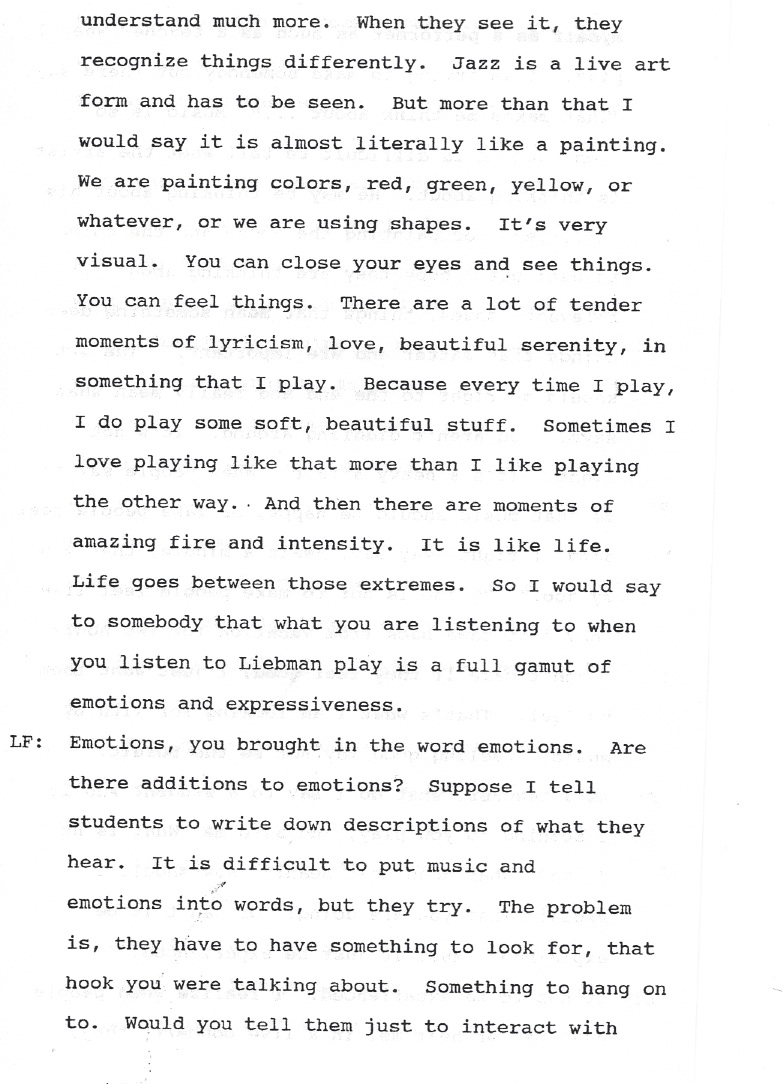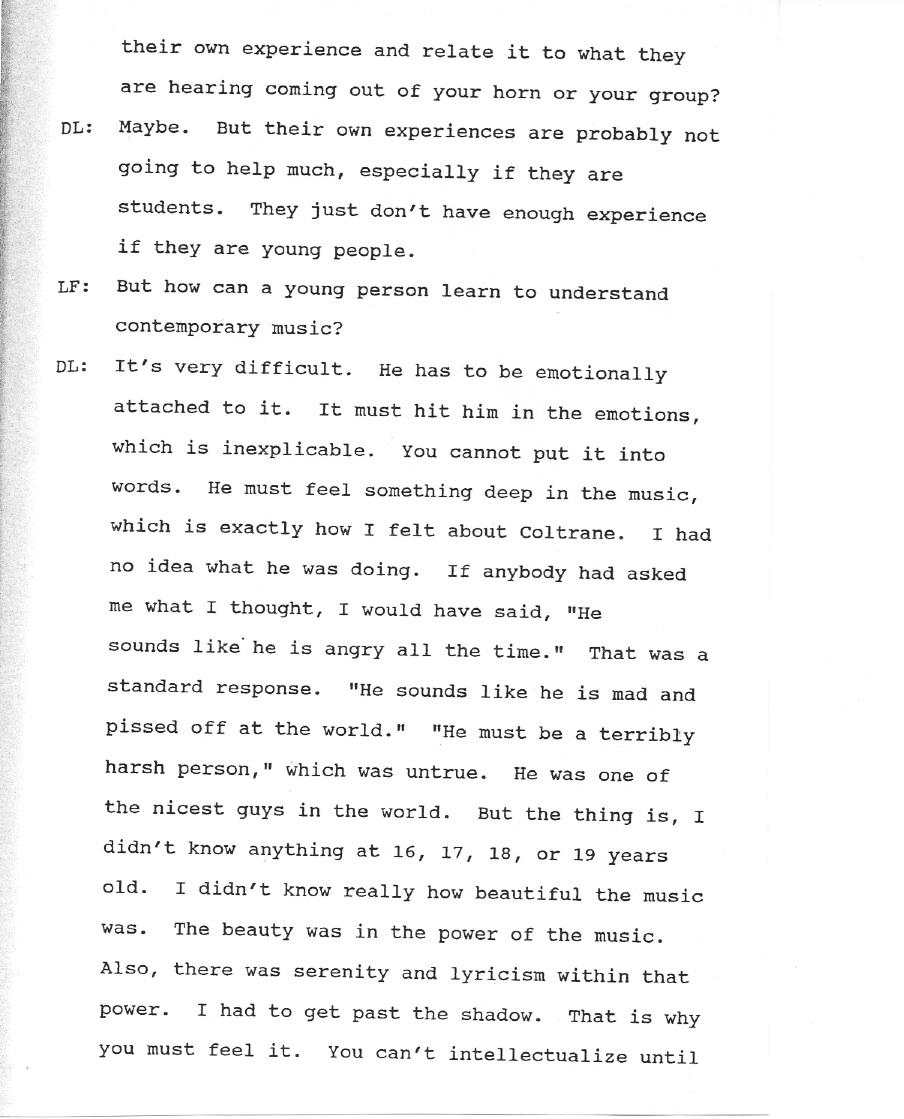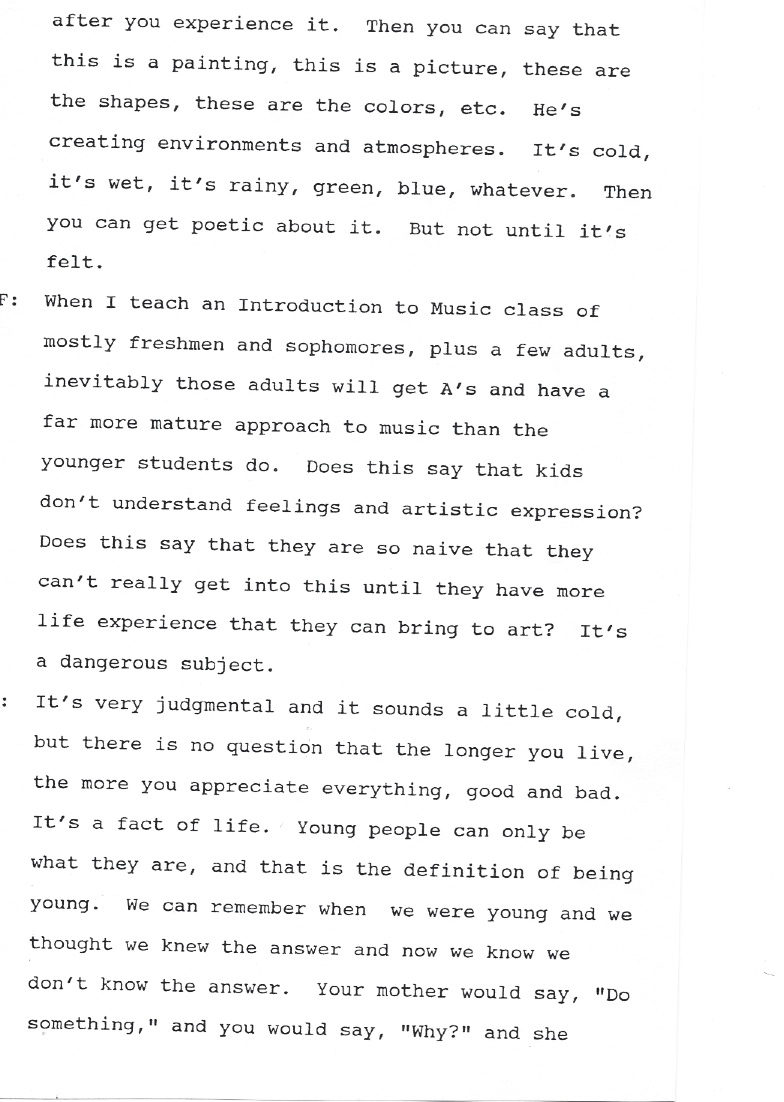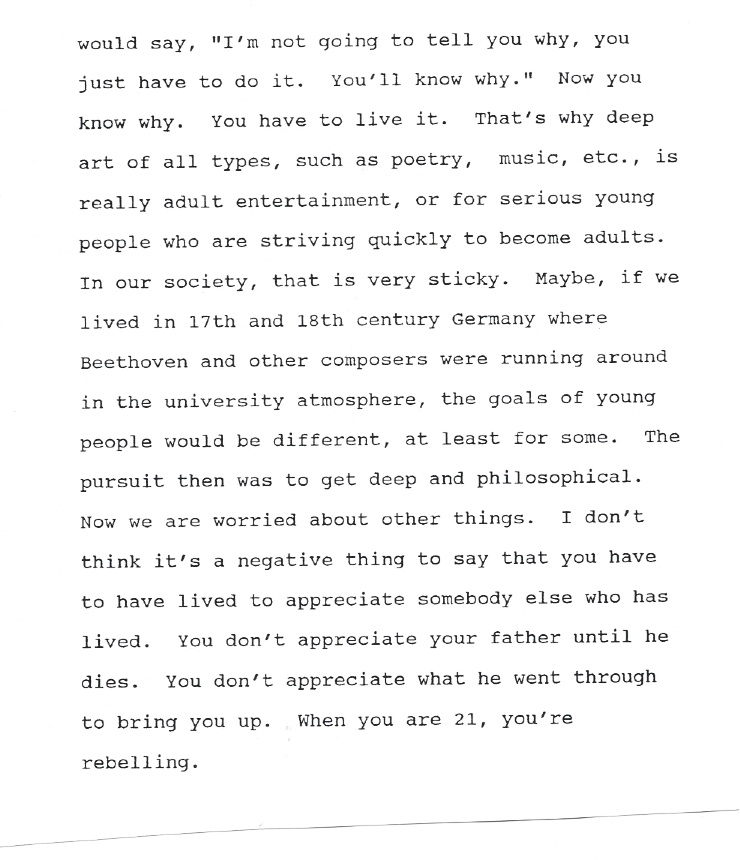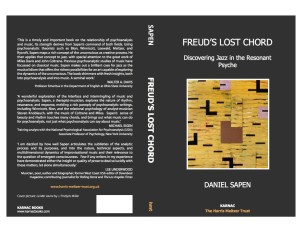With recent advances in neuroscience, the relationship between music and the brain has become the subject of new research and generated a great deal of public interest. Best sellers like Oliver Sacks’ Musicophilia (Knopf, 2007) and Daniel Levitin’s This Is Your Brain On Music (Dutton Penguin, 2006) have brought the attention of a wider public to the mysterious ways in which the billions of neurons (nerve cells) in our brain hear, process, and produce sounds that are meaningful and even memorable. Music accompanies us all our lives. It can be exciting, disturbing, soothing, comforting, joyful, sad, and even therapeutic. Music plays a significant role in many of the rituals, ceremonies, and rites of passage in all cultures. How in the world are a bunch of nerve cells supposed to do all that?
And what about jazz in particular? Improvised music challenges the brain’s ability to multi-task in rapid succession. Recently, neuroscientists have become interested in the brain’s capability for jazz improvising. For example, they have begun to study brain activity when musicians play composed versus improvised passages. To explore this fascinating work from the standpoints of a musician and a neuroscientist, All About Jazzbrought together NEA Jazz Master saxophonist and educator Dave Liebman and scientist Michael Kaplan, who teaches neuroscience in the Biological Basis of Behavior Program at the University of Pennsylvania, to discuss how the brain works to make improvised jazz happen. These two bright minds engaged in a fascinating dialogue about the skills required and how the brain acquires them, the neurobiological basis of musical talent and learning, the “telepathy” that occurs when jazz players co-improvise, and the cultural and developmental factors that make jazz a personal and communal experience, always coming back to the light that neuroscience can shed on the subject.
All About Jazz: How did each of you become interested in jazz as it relates to neuroscience? What made these two areas, which are usually not thought of in connection with one another, come together for you?
Dave Liebman: Even though I don’t qualify as an expert on neuroscience, I’m very fascinated by it. It always amazes me that in improvising, especially with other musicians and even cross-culturally, we players can deal with the astounding amount of input and information involved in coordinating the notes of the scale, all the emotions and moods, distractions, and random thoughts that are there. How does the brain sort it out and put it all together into a creative musical moment? I’m very curious about what is going on in the mind and the brain when we do this incredible process called improvising. Of course, everyone improvises in life, having a conversation, responding in a driving situation. So, I always wonder, when you have a lot of input and things to be concerned about, how does the mechanism work?
AAJ: So you’re interested in how spontaneity and creativity operates in the mind and brain. Mike, how did you become interested in applying neuroscience to music?
Michael Kaplan: Music is of great interest to neuroscience, because it’s such a unique form of behavior. It’s ubiquitous, it’s found in all human cultures, and very, very ancient, and yet its origin and purpose remain unknown. It’s not absolutely necessary for survival, so why is it so widespread? And jazz is especially interesting because of improvisation: the recombination of previously learned materials, but used in a very spontaneous way. It’s a paradoxical kind of attention that you have to employ when you improvise, where you have to be aware of many things, but without getting bogged down in all that information. It’s that mixture of control and “letting go.”
DL: That may be true in the best of worlds, but for me there may be times when I’m playing when I’m on automatic pilot. The fingers are doing the walking, and at the same time in the heat of battle there may be a lot of anxiety, waiting around, fatigue, a lot of mundane things. Like I say to students, your fingers are way ahead of your brain. So it swings from total concentration to times when your mind is all over the place, but you’re still performing!
AAJ: Sometimes it’s as if the brain is doing something that your conscious self isn’t aware of doing.
DL: Yes. My fingers are working, while I’m AWOL!
AAJ: It’s like driving a car. You’re thinking about your wife, your kids, the next exit on the highway, but hopefully you’re still working the steering wheel and the brakes!
DL: Exactly!
AAJ: Before we go any further. I’d like Mike to give us a feel about brain science as such, because most people aren’t aware of what the scientists are doing in their laboratories. Take us into one of the labs, tell us what equipment is used, how musicians are utilized in the studies, what the research is all about. [Please note the links provided for further information when technical terms are introduced. -Eds.]
MK: Unlike a lot of neuroscience which uses animal models, subjects like the neuroscience of music have to be worked out using human subjects. So we use non-invasive methods that can show the anatomy and the activity in the brain without having to open up the skull or otherwise harm the subject. These include MRI (magnetic resonance imaging), which looks at the anatomy; fMRI (functional MRI) , which looks at changes in blood flow as an indication of which parts of the brain are more or less active; and PET-scans, which can add some chemical specificity, like which neurotransmitters are being released in what parts of the brain. We can also use electroencephalograms (or EEGs). You may have seen photos of people wearing EEG headgear with pads and jelly stuff, and a lot of wires coming off it. These are for measuring electrical activity of the brain, again, right through the skull.
These are great tools, each with their advantages and disadvantages, but they’re just tools. They don’t tell you much unless you have a very well-designed experiment. So the trick is coming up with a matched control task, so you can say how much of all the activity you are measuring is specific to the object of study, and which is incidental. Consider improvisation. We want to find out which parts of the brain are involved in generating novel phrases during a solo. But there’s so much else that is going on that we have to sort out! The musician is listening, so the auditory system is involved. The motor system is active just to move the musician’s fingers. The somatosensory system feels not only the instrument in the hands, but also the tie that is too tight and a lousy cushion on the chair. The visual system is active if there is a chord chart, or just from looking at the band and the audience. And as Dave said, the musician might also be thinking about a lot of other things too. So the trick is to come up with a task and a matched control so that you can literally subtract one pattern of activation from the other and see what the difference is.
AAJ: Can you give a specific example of how this works in the context of musical improvisation?
MK: In one of the first studies using fMRI to study improvisation, Charles Limb and his colleagues put jazz musicians in a scanner and had them improvise, first on a major scale with just eighth notes, and then in a more complex and natural way. Limb monitored all the brain activity that was happening. Then he had them learn and play several pieces from memory, with the same overall note density as the improvised solos. Finally, he subtracted the pattern of activity when playing from memory from the pattern of activity while improvising, and what’s left is specifically the brain activity due to the task of improvising as such. And he found parts of the Prefrontal cortex that were more active during improvisation. He also found parts of the prefrontal cortex that were less active during improvisation. These opposite changes in different parts of the frontal cortex may in fact have something to do with that sense of both being in control and letting go that we’ve been talking about.
The Tasks and Skills Required for Musical Performance
AAJ: That’s a great example of how you can sort out which brain activity is related to specific tasks involved in making music. There are many different tasks that lead up to a good performance: composing, practicing scales and arpeggios, woodshedding phrases and lines, and then actually doing the show. Dave, tell us a bit about how you practice to prepare for improvisation-what sorts of activities, and what’s going on in your head?
DL: When you’re sitting and practicing, you’re usually at home alone, while performing jazz is a highly collaborative effort. So practicing, composing, all those activities you do alone are very different in that respect from when you’re on the stage performing with a group and with an audience in front of you. There’s a big difference when you’re at home working alone than when you go into the public eye, picking up the vibrations from the audience and your interaction with two, three, four or more other people. That’s completely different from what you do at home by yourself.
At home, you’re concentrating on repetition, understanding the music, getting your mind to move with or ahead of your fingers, etc., etc. They’re technicalities that are similar to learning a language. So hopefully if you’re a good practicer -which is an art in itself -you’ll focus on something which will give you an advantage when you go out into the world performing and have to rely on spontaneity to bring up all that information which you’ve acquired. So what does neuroscience say about what I’m doing when I’m practicing and preparing as opposed to when I’m performing at a microphone in front of an audience and suddenly a whole bunch of new impulses are happening?
MK: Dave, in your practicing routine, how much of that time is actually spent improvising, as opposed to drills and scales?
DL: Not so much, actually. Mostly, I’m getting things ready to go out there and play -chops, reeds, etc.
MK: Interesting. The difference you are describing between the way you practice and the way you go on to use what you learned in a performance brings to mind the difference between episodic memory and procedural memory. Episodic memories are facts, things, places—basically the kind of knowledge you can show or describe with words. Procedural memories are more like skills, like riding a bicycle: once you learn how to do it, you don’t have to think about it in words anymore. You do it automatically. Words were involved when you first learned how to ride -you may have been told “Don’t turn too sharply or you’ll flip over” and “Remember to lean into the curves” and so on -that’s episodic memory. But once you really learn to ride, all this becomes automatic. You don’t think “I should lean into the curve”-you just do it. That’s procedural memory.
DL: When I’m teaching a class of student musicians, and we are finishing our time together, I tell them: “When you go out of here, you’re gonna need to know how to practice and what the rules are and make what’s not intuitive become intuitive.”
MK: What you’re calling making “what’s not intuitive more intuitive” sounds a lot like going beyond conscious, episodic memory to procedural memory.
AAJ: Mike, can you give us a picture of what goes on in the brain between the practicing phase and the performing phase?
MK: Over the long term, practicing has many effects on the brain. Some parts actually get bigger, or show stronger electrical responses as a result of practice. Other parts seem to be more strongly connected to each other. In the practicing phase, when you’re still learning the tasks, you’re going to be learning them from books, words, and facts, but over the course of repeating them over and over again, in order to use them to perform, you have to learn them as procedural memory. These appear to be two parallel systems-it’s not a series, where episodic memories are transferred into procedural memories. And we think there are at least two different brain systems involved. The brain system that mediates episodic memory is centered around the hippocampus . It looks a little like a seahorse (“hippocampus” is the Greek word for seahorse), and it is curled around deep inside the temporal lobes (one on each side). If the hippocampus is badly damaged, the result is anterograde amnesia, the inability to form new episodic memories. So the hippocampus is involved in the storage of new knowledge and facts.
The other part of major memory systems that we know about involves the striatum, another group of structures underneath the cortex, the big wrinkled part of the brain. The striatum is part of an important functional loop from the motor cortex, through the striatum and back to motor cortex again before sending the output down the spinal cord. And we think that a lot of procedural learning, especially motor learning, involves the striatum. We think that’s true because we see what happens when people get specific kinds of brain damage. Damage to the striatum is likely to affect these procedural skills, whereas damage to the hippocampus takes out your episodic memory for facts, etc while leaving skills (like riding a bicycle) largely intact. Interestingly, patients with little or no hippocampal function, while they can’t learn new facts, can still learn new skills! They would get better with practice, even if they had no conscious memory of ever having practiced at all.
That’s how we know that these two systems of episodic and procedural memory run simultaneously, in parallel. But when you’re improvising, your procedural memory has to take over. You can’t be thinking, “What note or chord am I going to play next?” Just like riding a bike, it has to come out effortlessly because you’ve mastered the process.
AAJ: In playing a musical instrument, a lot of what you call procedural memory involves motor coordination -hitting the keys on the saxophone or piano or moving the slide on the trombone, and so on. That is sometimes called “body memory.” Mike, what is the role of the body in jazz improvising?
MK: I think that it is this sense of effortless execution, without feeling like you are conscious of the details, that people mean by “body memory” or “muscle memory.” And that’s procedural memory in action. When you learn a scale or a riff to the point that you can call it up instantly in an improvisation, the learning isn’t actually happening in your muscles, although it really feels that way, and they do in fact get stronger over time. The important change is actually in the brain, in the storage of procedural memory.
Musical Talent and Practice
DL: That raises the question of what makes some people better improvisers than others. Like what makes John Coltrane better than say, your cousin? Is it because Trane practiced so much? Is there some threshold that takes you to a new level of ability?
AAJ: We know that Coltrane practiced constantly, even late in his career. But what made him so uniquely creative in his improvising?
MK: That is a great question. Recently, some writers have tried to argue that practice is all there is—that there is no such thing as “talent” at all. Malcolm Gladwell has popularized the idea of a threshold of ten thousand hours of practice to achieve mastery of complex skills like music. But I think this position is a misreading of the evidence. For example, one of the studies he cites looked at students at a violin conservatory, and found that the most successful ones practiced the most, and the average was ten thousand hours by age twenty. But this is a group of people who have already been selected for being extremely talented to begin with! People who don’t have strong musical talent aren’t going enroll in a conservatory, let alone practice for ten thousand hours! These kinds of studies show that practice is necessary, but not that it is sufficient. It certainly doesn’t show that there’s no such thing as talent. Dave, when you teach and mentor, do you find that some people learn music very quickly, and some with more difficulty?
DL: Yes, and it also raises the question of just what it is that we call musical talent. Playing Bach is somewhat different from playing jazz and so on. This raises the question of what the brain brings with it when you’re born, what is innate potential?
MK: The short answer as far as innate potential is, we don’t know. Many differences have been described in the brains of adult musicians -they have a larger Heschl’s gyrus than non-musicians for example -but to figure out which differences result from practice and which represent an innate talent is a more difficult question that hasn’t been answered yet. It’s a very difficult study to do: you would need to find a bunch of really good musicians, and then go back in time to scan their brains before they started to play music! Or, more realistically, do a very large (and very expensive) study that scans several hundred very young children, and then follows up 10 or 15 years later to see if any of them turn out to be accomplished musicians. A large enough study to answer these questions has not yet been done. My personal opinion is that we won’t find any particular anatomical difference that can account for the innate components of musical skill. But we may in time find a genetic or biochemical signature. The brain stores information by changes in neurons and their connections (synapses), changes we callneuroplasticity . These changes depend on specific molecular pathways, and the molecular players come in different “flavors” (or isoforms), both between individuals, and in different parts of the brain. Some of these isoforms are associated with more rapid neuroplasticity. So a person might have a high potential for neuroplasticity-that is, for learning-in one set of brain regions, and another person with a different regional distribution of these molecules might have a very different set of potentials. Is it innate or learning? Actually, it’s a combination of the two. The undeniable part of musicality that is innate may be in fact turn out to be the capacity for learning.
DL: And in addition to skill, what about artistry?
DL: And in addition to skill, what about artistry?
AAJ: And the ability to create great new lines and ideas, original styles, etc. Dave, what’s your sense about those elusive traits of originality and creativity?
DL: Well, for one thing, you have to be highly motivated. You have to really want it, you have to work really hard, you gotta love what you’re doing. Then, it’s what you come in with at ground zero. How good is your ear and your sense of rhythm? Are they acquired through experience, or do you get it in your mother’s belly? There’s research suggesting that music affects life in the womb.
MK: Several different groups have reported that by the time they are born, babies already have a different reaction to their mother’s voice. But I’m not aware of any good reports of the effects of music specifically on fetal development, beyond a few anecdotes. (By “good reports,” I mean a peer-reviewed article with a proper control group). As to your other question, about going beyond skill to the question of artistry and creativity-um, don’t you have any easier questions? Clearly a high level of skill is a prerequisite for being a great improviser. But what else? One way to approach this question is to ask whether there are any domain general aspects to being a great improviser, ways of thinking that aren’t specific to creativity in music, or in language, or in engineering, but apply equally to all of them. One candidate is divergent thinking, exemplified by the ability to think up multiple solutions for the same problem, or multiple uses for a common object. One researcher was able to predict expert ratings of a group of jazz soloists using their scores on a test of divergent thinking! The musicians who received higher ratings as improvisers scored higher on divergent thinking.
DL: Where does personality come into this? For example, Coltrane was very spiritual. His father and uncle were involved in the church. Were those experiences part of what made him so original and creative? Does neuroscience say anything about personality and autobiographical factors?
MK: Charles Limb found that a lot of the frontal and pre-frontal cortex, an area of the brain that determines a large part of our personality, was actually shutting down, displaying less activity during improvisation. But there was an area in the medial prefrontal cortex which was very active. And this is an area that has been identified with self-expression and self-awareness. It may be that the connection between personality and improvisation may lie in the neural connections between the medial prefrontal cortex and the motor and pre-motor regions where skill resides.
DL: How far can they go with this? Will the researchers ever be able to look at the brain activity and say, in bar 17, while he was playing such-and-such, Dave Liebman was thinking about lunch? [Laughter].
MK: Well, “never say never,” but probably not anytime soon. Your secrets are safe, Dave; for now, anyway.
Musicians Interacting: Co-Improvising and “Telepathy”
AAJ: You’re almost talking about neuroscientists reading your mind, which also relates to the question of how jazz musicians are almost telepathic in sensing what their co-musicians are thinking or are going to play next.
MK: I don’t think neuroscience will ever be as good at that as the musicians are.
AAJ: The public does have the idea that neuroscientists can read minds. But we know that musicians can come very close to doing that when they co-improvise, so how can they do it so quickly and efficiently?
DL: You’re talking about the immediacy of understanding each others’ musical ideas and intentions, very rapidly and based on what they’re playing.
AAJ: What is remarkable to me is that the jazz musician can be simultaneously listening and playing in real time, take the input from the other musicians, and use it in a creative way, right in the moment. How can the brain process all that information so quickly and make rapid-fire decisions about what notes to play, all once?
DL: And wouldn’t it be great if we could harness that ability in other aspects of our lives. Co-improvising really is a magical thing, and if we could harness that ability to be creative together in all aspects of our lives, it would be wonderful. I started my education organization, The International Association of Schools of Jazz, with the idea of cross-cultural communication and learning, and it has expanded to forty countries. Music has the ability to reach out beyond place and time.
MK: You’re touching on one of my favorite topics: what is cross-cultural and what is culture-specific in music? Maybe part of what enables jazz musicians from different cultures to perform together is a reflection of what is universal in music, and an extension of the same universal tools we use in listening, not just to music but to language and other kinds of sounds.
Leaving aside for the moment these questions of culture specificity, how do jazz musicians manage the feat of improvising together, in real time? In co-improvising, musicians have to understand what’s happening, anticipate what’s coming next and formulate a response, and connect it to the motor programs that put it into action on their instruments. Some of this appears to involve enhanced connectivity between frontal, premotor and supplementary motor cortex and the auditory cortex. Connect ivity refers to the extent of synchrony or relatedness in activity between two brain regions). Some of it involves being able to call on motor programs that have been over-learned through practice, so they can be put into action without attention to the details. And that’s where we get back to Dave’s observations about practicing. By practicing, the musician makes all those motor programs procedural, as automatic as riding a bike, so that when you want to use them, you don’t have to take the time to think about how.
But there’s still that additional ingredient which is hard to get a hold of. You can practice a lot until it becomes automatic, but you still have to go with the flow of what’s happening in the moment, and not everyone can do that, even if they practice a lot.
DL: That’s hard even for the best of us. I remember Dizzy Gillespie in his autobiography saying: “I can count on the fingers of one hand the number of times that everything worked.” I think he meant the times when everything is in a perfect place, your fingers are working, you’re in synch with the other band members, the audience is there with you, and you’re king of the world. Maybe Dizzy was being modest, but he’s right that those perfect moments are very rare.
Group Cohesion, Rhythm, Anticipation, and Emotion
AAJ: In terms of what Dave was talking about, does brain science tell us anything about why music is so important in bringing people of diverse cultures together around their common humanity? Music creates a group cohesive affect: the audience can feel almost like one person.
DL: I think it’s the fact that music is so universal. It’s in the ears of the beholder without any dictums, ideology or prejudice. Music is “in the air” and equalizes everyone.
MK: I think that part of what you’re talking about gets back to the idea of anticipation. When we’re listening to music together, to the extent that we all understand it, we can all anticipate where its going, and we’re all thinking the next sound or thought together. We’re all in synch because the music is prompting the same thought in all of us. What makes some music universal across cultures is that everyone hears the setup and anticipates the same event coming next. That’s what brings us all together.
DL: But it’s more complicated than that. The Western world is used to the seventh tone resolving to the root. But that’s not true in all societies or cultures.
MK: True. But cultures who don’t understand a word of each others’ languages may find that the music of the other is much more understandable then the language or just about any other thing about them. If we ask you to complete a sentence in a language from an unfamiliar culture, you wouldn’t be able to do it. But if we play you a passage of their music and ask you to complete the phrase by predicting the next note, you might not be as good as a native, but you’ll be right a lot of the time. Some things in music are practically universal across cultures, like octave equivalence, and commonalities with the twelve tone, major, and pentatonic scales. So there’s something familiar to us in the music of nearly all cultures.
Music and Meaning
AAJ: But in order for music to bring people together, in addition to familiarity, doesn’t it have to have a personal meaning that’s common among them?
MK: Maybe. But I think that stomping or grooving to a beat together is sharing something meaningful and very personal. The music itself, and listening and moving to it together, is what is shared, apart from any other kind of personal meaning or lyrics beyond that. There’s actually research showing that performing a rhythmic task together enhances the ability of groups to work together on subsequent tasks. Some evolutionary biologists believe that this ability to help people work together is one of the reasons music evolved in the first place.
AAJ: You both seem to be downplaying the symbolic and emotional meaning of the music. Leonard Bernstein, in his famous Norton Lectures (The Unanswered Question -Six Talks at Harvard by Leonard Bernstein, Kultur Video, 2001), argued that music has syntax and meaning much like a language. He held that music conveys meaning through through the sequences of notes that are manipulated by the composer to convey a feeling or a sense that we all understand. So if you’re listening to Miles Davis’ Sketches of Spain(Columbia, 1960), it’s not just the sounds themselves, which are interesting in their own right. In addition, something deep within you is affected by it in a meaningful way. It’s as if various brain centers must come together -the language center, the centers that produce images and memories, the emotional parts of the brain stem, and so on. Then it means something personal to you.
DL: But not everyone can dig that album like you do. Some aspects of music are not universal, but depend upon personal experience and taste.
MK: And in fact, jazz can be a hard sell for the average listener today. That brings me back to anticipation again. Some people don’t like jazz or other forms of music because they don’t know “where it’s going,” they’re not getting the same prompts that the experienced jazz listener does. They’re not getting a pattern lock on the music, and can’t make any predictions. At this point most people throw up their hands and say, “I don’t like that. It’s just noise.” They don’t hear the pattern.
DL: Yeah, think about the later Trane, or the composer Arnold Schoenberg and what he did with twelve tone rows instead of scales. Lots of people don’t get it at all.
MK: Most people, in fact! Schoenberg is a great example, because he deliberately made it impossible for the listener to use the scale to predict where the music is going. He took away tonality, one of our main sources of anticipation. We still have rhythm, and we can still recognize one of his strangely constructed phrases when he plays it again, so that we can anticipate what’s coming next. But our “go-to” framework for anticipation, tonality, is missing. This is very disorienting for most of us.
DL: Rap music is even worse than Schoenberg in that respect! Rap has taken away melody, harmony, and any kind of looseness in rhythm.
MK: But the rhythm is usually steady enough that no one gets lost. Rhythm is another “go-to” framework for anticipation, isn’t it?
DL: And of course there’s also the lyrics. Besides tonality, words and rhythm are probably the most important connectors between performer and audience in music.
MK: And there are also larger frameworks, expectations that are embedded in the social setting that comes with a genre of music.
DL: True. If you go back to Bach, a lot his music was performed in a church; it’s pious; you have to listen very seriously to it. So your expectations are there before you even hear the first note.
Focus and Concentration
DL: I agree. It captured the experience in an urban setting. It was the quintessence of twentieth century life. But, of all the things we’ve talked about so far, the thing that interests me the most, surprisingly enough, is all that’s going on in my brain that has nothing to do with the music! Because if I could learn about that, and control it, I might be a better, more focused musician.
AAJ: You mean total concentration.
DL: Yes, total concentration on the music.
AAJ: How does the brain get to single-minded concentration? Some people strive for that when they meditate, for example.
DL: Yeah, it’s about how not to be distracted by one thing or another. Phil Woods once got an unintentional lesson in concentration from Charlie Parker. He once told me a story about how he met Parker. They happened to be playing across the street from one another on Seventh Avenue in Greenwich Village. Somebody told Phil that Charlie Parker was across the street performing with a pianist and said that for some reason Bird was using a baritone saxophone. So Phil goes across the street to hear Bird, and sure enough he’s playing baritone sax. Woods goes up to him and says, “Mr. Parker, I play alto saxophone. Would you like to use my horn?” Now Woods was going through a period of his career when he was blaming all his faults on his saxophone. But he gives Parker his horn, and Bird sounds unbelievable, and he tells Phil, “Young man, this is a great saxophone. You’re lucky to have it!” At that moment, Phil realized it was himself, not his sax, that was the problem, and he started practicing a lot more! My point is that in the heat of improvisation, you’re distracted a lot with extraneous thoughts: where to get lunch, getting paid, the instrument doesn’t feel right, etc. Something has to make you take responsibility for what you’re doing and focus on the music.
MK: I don’t think the research has yet been done to answer your question about what the brain does to focus. Some scientists are trying to identify what’s happening in those moments of peak concentration that psychologists call “flow.” This research pointed to the importance of the neurotransmitter dopamine, which is important for the regulation of motivation and mood but also for the experience of intense pleasure. Dopamine is also essential for the efficient initiation of motion. Motivation, mood, pleasure, and movement-sounds like a good transmitter for making music, don’t you think?
How would we study this question? Maybe we can compare moments of distracted soloing with other moments of peak concentration in the same solo. We’d want to use EEG instead of fMRI or PET scanning because we need a fast response (EEG can distinguish events on a millisecond time scale. Brain scans are slower than that). In an imaginary experiment, Dave would play some solos with both audio and EEG recordings and then we could go back and listen to the solo together, to identify the passages where he got distracted or thought about something other than the music, and the passages where he was really focused on the music. And we could see if there was anything different in the brain activity. Actually, I think this would be a good experiment to do!
DL: I’m such an analytical guy, that I think I could identify where I was distracted versus where I was really concentrating and having a peak experience, really into the music.
Helping Babies Grow Up to Be Jazz Musicians
AAJ: Let’s wind up with a hypothetical question. Parents like to imagine what their newborn baby will be when he or she grows up: a lawyer, a doctor, raise a family, etc. If you could take a newborn baby and do the things that would make him become a great jazz player when he grows up, what would each of you do? In other words, how would you prepare the infant’s brain to be able to be a top jazz musician?
DL: Funny you should mention that. I can tell you that when my daughter, Lydia, came out of the womb, and as the doctors cleaned her up, the first thing she heard was Coltrane’s “Crescent,” and then I played my little wood flute for her! To take that further, the point is to expose the kid to great music as early as possible. That’s it! Did you see the YouTube of the kid who was exposed to great music from birth, and when he’s eight years old he has perfect pitch. The father says, “I even put the speaker next to my wife’s stomach when she was pregnant!” When he’s twelve, the kid is a musical genius!
MK: I think the evidence is pretty good for some very simple learning shortly before birth, in the womb, at the level of being able to recognize their mother’s voice (arguably just about the only thing most fetuses could possibly hear with any clarity) but I’m generally mistrustful of conclusions beyond that drawn from anecdotal accounts. The father on YouTube, for example, has no way of knowing whether his son would have had perfect pitch anyway, even without musical exposure in utero. It is true that some early exposure to music is necessary for the development of perfect pitch. But most kids who develop perfect pitch didn’t get that any kind of in utero treatment.
AAJ: Dave, I know that Lydia is a very gifted singer. [At twenty-five, she has released her first jazz album with Dave’s group, Familia, CD Baby, 2016-Eds.] But does she like to listen to “Crescent” today?
DL: I don’t know, but she likes Coltrane. Here’s a cute story: at one point in her early teen years, Lydia was listening to rap a lot, and I was very worried, I almost flipped out! Then one day, she’s sixteen, and her inner alarm clock goes off with new music, and she’s listening to Coltrane’s “A Love Supreme”! So I asked her what’s going on. She said, “I found it in your collection, and I kind of like it.” And she hasn’t gone back after that, thank God!
MK: My advice for parents was going to be the same as yours. All you can or should do is expose a little kid to a lot of music, and see what sticks. As far as actual musical instruction, some of the research I mentioned about functional connectivity found that improvising as part of practicing may be very important, at least as far as the apparent brain activity. People who had grown up improvising had different patterns of brain activity, with more connectivity between premotor and motor cortex, than those who also became good musicians but hadn’t practiced improvising. They also found that most of the proficient improvisers in their sample did report improvisation as part of their practice routine from a very young age.
DL: I’m not an expert on teaching young kids, but I think the first thing you teach them should be improvising: here are two notes, do what you want to do with them? Let them play with the notes. Then jump ahead a couple of years, and give them the blues scale and let them play with it.
AAJ: I see that we’re running out of time. This has been a fascinating discussion, and I’d like to thank you both for participating. Mike, could you please sum up our excursion into jazz and neuroscience for us?
MK: As a student of both music and the brain, I’ve enjoyed hearing the perspective of such an accomplished improviser (thanks, Dave!), and I hope these kinds of experiments are interesting to the readers of All About Jazz. And I also hope it’s clear that musicians, fans and critics have nothing to fear from the neuroscience of music. Explaining something in neuroscientific terms isn’t “explaining away” anything about the experience, which “is what it is.” There is no conceivable finding from neuroscience that can diminish the greatness and the excitement of a great solo, or compel a listener to like (or stop liking) their favorite music.
Scientists study music because we love music. Trying to think about just how the brain pulls off this most amazing feat of jazz improvisation can only enhance our appreciation, not diminish it.
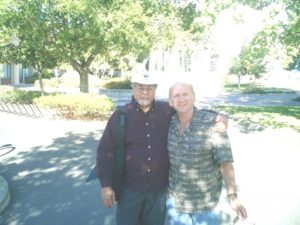


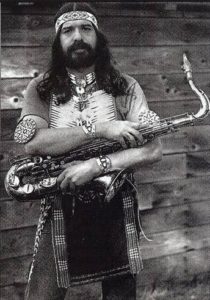

 First of all, we have to acknowledge that the jazz public is getting older worldwide, specifically in the U.S. and Western Europe, younger in Eastern Europe, South America and Asia so far. Along with ageing comes the natural inclination to want to recall the past, referred to as nostalgia. It may sound corny but it is a natural human desire to revisit happy times. Outside of horrific tragedy everything looks better in retrospect. We tend to remember things in a more positive light than it might have been at the time.
First of all, we have to acknowledge that the jazz public is getting older worldwide, specifically in the U.S. and Western Europe, younger in Eastern Europe, South America and Asia so far. Along with ageing comes the natural inclination to want to recall the past, referred to as nostalgia. It may sound corny but it is a natural human desire to revisit happy times. Outside of horrific tragedy everything looks better in retrospect. We tend to remember things in a more positive light than it might have been at the time.

